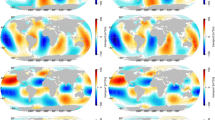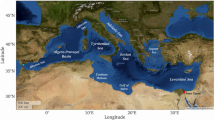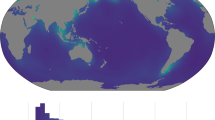Abstract
INTEREST has recently revived in the possible effects of the sea tides on the Earth's magnetic field; modern instrumentation has made direct measurement possible1,2. Malin3 has shown how the semi-diurnal lunar variation arising from the ocean and sea tides may be inferred from the complete lunar variation observed at any given station. The time seems appropriate to begin work on detailed theoretical models taking into account the topography of the coastline. Here we continue work4,5 specifically aimed at understanding the magnitudes and distributions of ocean and sea tidally induced magnetic fields over the British Isles.
This is a preview of subscription content, access via your institution
Access options
Subscribe to this journal
Receive 51 print issues and online access
$199.00 per year
only $3.90 per issue
Buy this article
- Purchase on SpringerLink
- Instant access to full article PDF
Prices may be subject to local taxes which are calculated during checkout
Similar content being viewed by others
References
Hill, M. N., and Mason, C. S., Nature, 195, 356 (1962).
Larsen, J. C., Geophys. J. Roy. Astron. Soc., 16, 47 (1968).
Malin, S. R. C., Planet. Space Science, 17, 487 (1969).
Kendall, P. C., and Chapman, S., Q. J. Mech. Appl. Math., 23, 535 (1970).
Chapman, S., and Kendall, P. C., Planet. Space Sci., 18, 1597 (1970).
Pekeris, C. L., and Accad, Y., Phil. Trans. Roy. Soc., 265, 413 (1969).
Leaton, B. R., Malin, S. R. C., and Finch, H. F., Royal Observatory Bull., No. 63 (1962).
Author information
Authors and Affiliations
Rights and permissions
About this article
Cite this article
WINDLE, D., KENDALL, P. & GRETTON, H. Sea Tidally Induced Variations of the Earth's Magnetic Field (Leakage of Current from the Atlantic). Nature 230, 296 (1971). https://doi.org/10.1038/230296a0
Received:
Issue date:
DOI: https://doi.org/10.1038/230296a0



